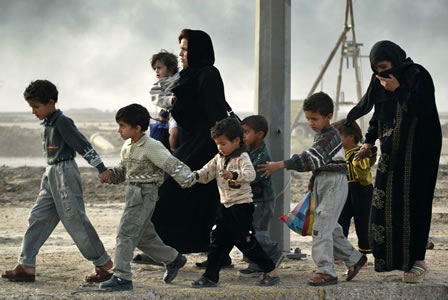Chilcot on Iraq’s civilian casualties
 Mike Spagat is a professor of economics at Royal Holloway College where he does quantitative research on war. Read his press release on Blair’s distortion of child mortality rates in Iraq here.
Mike Spagat is a professor of economics at Royal Holloway College where he does quantitative research on war. Read his press release on Blair’s distortion of child mortality rates in Iraq here.
The chapter on civilian casualties in the Chilcot report is stuffed with interesting material to the point that I don’t know where to start. So I guess I’ll make a somewhat random choice and start with the internal UK discussion on whether or not to compile and release data on civilian casualties in the Iraq war.
Iraq Body Count (IBC), my long-time collaborators, have produced a must-read piece on this subject which influences a lot what I write below.
One thing about the report that surprises me is is the strength and persistence of the interest from Tony Blair about civilian casualties. As argued by IBC, much of his interest seems to derive from the political/propaganda role of such figures, i.e., winning the “blame game” as IBC puts it. But Blair dis ask repeatedly over a period of several years for casualty information.
The Ministry of Defence (MoD) consistently opposed all ideas about accounting for civilian casualties, arguing that it’s impossible to get really solid figures so it’s best not to try. There was a clear recognition in some government circles of the inadequacy of this argument. For example, the military’s Permanent Joint Headquarters (PJHQ) warned that:
“The current line, that there is no reliable way of knowing how many casualties there have been…was perfectly reasonable during the decisive combat phase of Op TELIC….as long-range attacks meant that there was no source on the ground to verify … casualty numbers. Since…the end of decisive combat operations, this line has become more difficult to defend as confirmed cases of civilian casualties where UK forces are involved are recorded locally.”
In other words, the UK was sitting on plenty of useful raw information that should have been collated and released. It is true that such data would have been incomplete and flawed but the information could have been usefully triangulated with other data to clarify the humanitarian situation in Iraq. Indeed, the MoD argument is such a transparent case of making the best into the enemy of the good that I find it hard to believe that MoD officials offered it sincerely.
The Foreign and Commonwealth Office (FCO), like Tony Blair, wanted to arm itself with civilian casualty information so it could battle effectively with critics of the war. Foreign Secretary Jack Straw argued:
“….I am concerned that the current UK/US position – that ‘there is no reliable means of ascertaining the number of civilian casualties, even in post-conflict Iraq’ – leaves the field entirely open to our critics and lets them set the agenda. We need to find ways of countering the damaging perception that civilians are being killed needlessly, and in large numbers, by Coalition forces.”
“We need to find ways of countering the damaging perception that civilians are being killed needlessly, and in large numbers, by Coalition forces.” – Jack Straw
Thus, Straw assumes that Coalition forces are not killing civilians needlessly and in large numbers and wants to be supplied with numbers he can use to drive home these facts, as he sees them, to the general public.
Yet the interest of the FCO, and Blair, in civilian casualty numbers evaporates when people realize that the Coalition might be killing more people than the “terrorists” are. For example, a private Secretary to Tony Blair writes:
“You asked for an assessment of civilian casualties in Iraq, noting that we cannot let figures of 10-15,000 go unchallenged as if we are responsible for them….The FCO recommend that we stick to publicising terrorist responsibility for civilian casualties in individual incidents. Underlying this is concern that any overall assessment of civilian casualties will show that MNF [Multi-National Force – Iraq] are responsible for significantly more than insurgents/terrorists.”
This strategy of generally withholding data on civilian casualties while cherry picking particular enemy atrocities for publicity is alarming in the extreme for at least two reasons:
If the reality was that the Coalition was needlessly killing many civilians then the UK government was intentionally blinding itself to this fact, thereby foreclosing the possibility of making improvements.
The UK government would disclose civilian casualty figures to its citizens if these figures were good news, thereby betraying the public trust and forcing people to assume the worst in future when data are not made available.
There is more in the report on this subject but I think the essence and outcome of the discussion are clear. The UK did not compile or release civilian casualty statistics because such figures would not have been perfect and because government officials were afraid of what such figures would show.
Mike Spagat blogs at War, Numbers and Human Losses, republished with kind permission.
